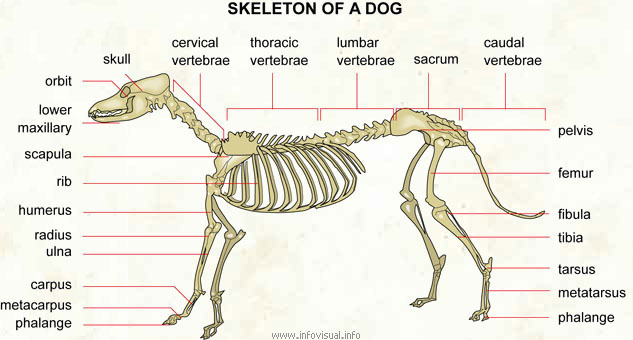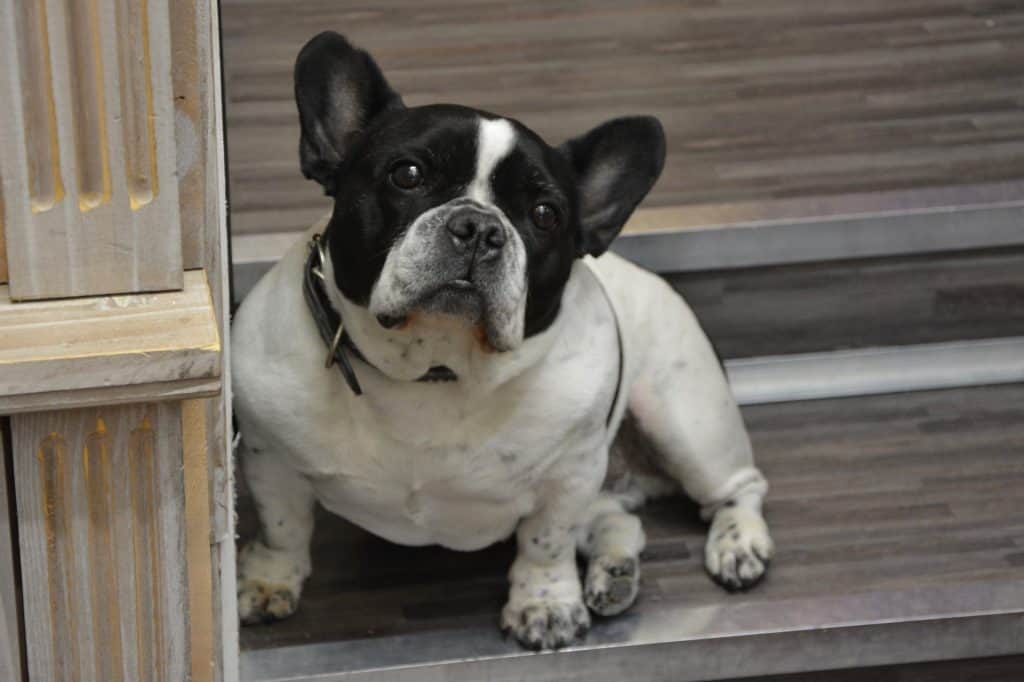For those curious about dog anatomy and physiology, the question of how many bones a dog has is interesting! Dogs come in all shapes and sizes, but regardless of breed, they all have a skeletal structure of around 320 bones. In this blog post, we’ll explore different parts of the canine anatomy to determine how many bones a dog has and how that can differ from breed to breed.
We’ll also look at how long the canine skeletal structure takes to develop and what common problems can affect a dog’s skeleton. Finally, we’ll answer some frequently asked questions related to the topic. So let’s start exploring the incredible mystery of a dog’s skeletal system!
How many bones does a dog have?
Overall, dogs possess an average of 319 – 321 bones in their anatomy. The alteration in this figure is due to the different tail lengths, with shorter tails having fewer vertebrae than taller ones. Additionally, certain breeds have additional bones in their rear dewclaws. Great Pyrenees and Icelandic Sheepdogs, have double dewclaws, meaning you’ll see two digits (with two nails) in the dewclaw spot.

How many bones does a dog have in its body? Details
According to Anatomy Learners, there are various bones in a canine skeleton – long, short, flat, irregular, and sesamoid bones. Let’s take a closer look at how many bones are in the skeleton of a dog:
- Bones in the vertebral column – 50
- Skull and hyoid bones – 50
- Number of ribs and sternum – 34
- Bones in the thoracic limb – 90
- Number of bones in the pelvic limb – 96
- Heterotopic skeleton (baculum) – 1
So, there is a total of 321 bones in the skeletal system.
How many bones does a dog have in its tail?
The tail is located at the rear end of the spinal column, marking the backbone’s end. A canine tail generally has between six and 23 vertebrae if the tail isn’t docked. These vertebrae are wrapped in flexible muscles that make movements easy.
Dog tails come in a wide range of varieties, from the long, flowing German Shepherd tail to the tightly curled tail of a Pug. A Greyhound has a long, thin whip-like tail, while a Labrador Retriever is medium-length and thick like an otter. The American Eskimo carries its tail high and coiled above its back, whereas a Border Collie keeps its tail lower.
The diversity among tails mirrors that of the breeds themselves.
Breeds with Different Bone Structures
Different breeds of dogs have other bone structures.
Smaller breeds such as Chihuahuas and Pomeranians, for example, have a lightweight body frame with delicate bones, while larger breeds like Great Danes and Saint Bernards are known for their large and robust build.
Each breed also has distinctive features regarding its skulls and legs: some may have thicker or longer leg bones than others, while some may have heads that are more elongated or have flatter faces.
Additionally, certain breeds, such as Greyhounds and Basset Hounds, are characterized by their sloping backs, which contribute to their distinctively graceful look.
Development of the Dog’s Skeletal System
Dogs have evolved over millions of years, reflected in their skeletal system development. Compared to wolves, domesticated dogs have more compact bodies, flatter skulls, smaller teeth, and a smaller skull size than their wild counterparts.
Their hips are often less massive, although strong enough to support their body weight. The ribcages in domesticated dogs tend to be shorter than those of wolves, and they also have longer legs due to their need for speed and agility in running activities such as chasing or fetching a ball.
A dog’s leg bones are shorter, resulting in a lower center of gravity, giving them better balance when running around. They also have flexible jointed limbs featuring multiple joints that let them rapidly rotate their heads up-downwards and sideways during fast land or water pursuits. This has enabled them to catch prey when hunting and helps them navigate tricky terrain at high speeds.
Finally, their skeleton structure constantly grows until about two years old; after this growth stops, the bone mass remains relatively unchanged for the rest of the dog’s life.

Common Problems Affecting a Dog’s Skeletal Structure
Dogs are susceptible to various skeletal problems that can cause discomfort, pain, and disability. These issues usually involve the bones, joints, ligaments, and tendons, which must be monitored for proper health.
Common skeletal problems include hip dysplasia, arthritis, intervertebral disc disease, elbow dysplasia, patellar luxation, cranial cruciate ligament rupture/injury, and Legg-Calve-Perthes syndrome. These problems can arise due to genetics or environmental factors such as an unbalanced diet or excessive exercise, which put additional strain on the skeleton.
Signs of these conditions may include limping or favoring one side when walking; difficulty jumping; stiffness or reduced range of motion in the legs; swelling in a joint or lameness; or lack of energy or enthusiasm for activities.
Early prevention is key in keeping these issues at bay, so owners should familiarise themselves with common signs and symptoms before they develop into more serious problems.
How To Take Care Of Your Dog’s Bones?
Taking care of your dog’s bones is essential for its good health. First, provide your pup with a balanced diet with bone-friendly nutrients like vitamin D, calcium, sodium, and phosphorus. This can help maintain strong bones and joints.
Additionally, incorporate plenty of exercise into their daily routine, which helps keep bones strong and healthy due to the movement stimulating tissue growth. Make sure you monitor the impact of their playtime, though—avoid activities that are too intensive or high impact, which could lead to injuries or joint damage.
You can also add supplements to your pup’s diet, such as glucosamine and omega-3 fatty acids, as this can help protect against degenerative diseases like arthritis in old age.
Finally, consult a vet if your pet is experiencing pain or discomfort in its joints or bones.
How Long Does It Take for a Dog’s Bones to Fully Develop?
The development of a dog’s bones varies from breed to breed, with larger breeds requiring more time for their bones to fully develop. For small dogs such as Chihuahuas and Pomeranians, the process usually takes around eight months to reach their full skeletal structure.
However, it can take 18 to 20 months for large breeds like Saint Bernards or Great Danes to fully mature from a skeletal standpoint.
Generally speaking, male dogs will develop faster than females due to higher levels of testosterone which helps increase the speed of bone growth.
Nevertheless, despite these differences in the rate of development, all breeds of dogs will reach fully grown status between one and two years.

Bone Disorders In Dogs
Common bone disorders in dogs can range from mild to severe and include a variety of conditions such as fractures, hip dysplasia, elbow dysplasia, arthritis, osteoporosis, and bone cancer. Fractures occur when bones break due to trauma or forces exerted on them that are too strong for their structure.
- Hip dysplasia is an inherited disorder affecting the hip joint in which the femur does not fit securely into the pelvic socket.
- Elbow dysplasia is a painful disorder resulting from the abnormal development of the elbow joint.
- Arthritis is inflammation and swelling in one or more joints caused by either infection or wear and tear over time.
- Osteoporosis is a weakening of bones common in older dogs due to changes in blood chemistry that reduce the body’s ability to absorb calcium.
- Bone cancer can occur in any breed but commonly affects larger dogs, especially those with growth hormone imbalances.
Treatment for these disorders depends on the underlying cause and severity of symptoms. Still, it could include surgery, physical therapy exercises, medication including steroids, diet changes, dietary supplements such as omega-3 fatty acids, etc.
Which animal has the most bones?
The python is the vertebrate with the most bones. These enormous snakes can reach up to 20 feet, and their body holds a total of 1800 bones – more than any other vertebrate animal! Humans have 206 bones.
Pythons have great flexibility due to all their bones, allowing them to quickly coil and grasp prey. They also have an unusually long lifespan for snakes; some pythons have been known to live for over 40 years.
The sheer number of bones in this incredible species sets it apart from all other animals!
FAQs of How Many Bones Does a Dog Have?
1) Are all dogs born with the same number of bones?
Yes, puppies are born with approximately 319 bones which gradually fuse over time as the puppy gets older, forming their adult skeleton.
2) Is there any difference between a male and female dog’s skeletal structure?
No, both male and female dogs share identical skeletal structures.
3) Does a larger dog breed have more bones than a smaller breed?
Generally speaking, no; larger and smaller canines should inherit roughly the same number of bones when they reach adulthood.
4) My dog is limping; could this be due to a problem with its skeleton?
Yes, if a dog is limping, it could be due to a problem with its skeleton. Skeletal issues may arise due to trauma or injury, arthritis or other degenerative joint diseases, hip dysplasia, luxating patella disorder, bone tumors, and congenital deformities. It is important to consult a veterinarian who can assess the condition and suggest suitable treatment.
How many bones are in a dog? Final Thoughts
In conclusion, dogs can have a range of 319 – 321 bones in their bodies depending on the breed and tail length. Some dogs even have double dewclaws, meaning they sport two digits rather than just one.
Knowing how many bones are in a dog helps us better understand its anatomy, making it easier to care for them. Whether you own a pup or not, it’s always important to understand your furry friend inside and out!
Recent Posts
As a dog owner, you want to ensure that you take proper care of your furry companion. A common question that many pet owners have is, "Can I walk my dog 30 minutes after eating?" Understanding the...
Have you ever considered getting an elevated dog bed for your furry friend, but wondered if it's worth the investment? If so, you're not alone. As dog owners, we all want to provide the best care for...

